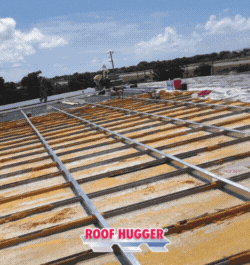Can you see the very common mistake?
« Back To Roofers TalkI see this will all types of material. 3-tab, dimensional, whatever.
.jpg)
Oh, that folded wing will completely close the contact area of the pan and the last piece of step-flashing from the sun and any wind blown rain. It gets tapped all the way around.
Here's a view of the detail. I stop the bending at this point and now install my side counterflashing behind that wing, and then finish closing it off similar to this 100+ year old one.
.jpg) I couldn't find any trace of caulk in this old one, and the roof had settled almost 2". You could look all the way across the 60" back pan underneath it and it didn't show any evidence of ever leaking.
I couldn't find any trace of caulk in this old one, and the roof had settled almost 2". You could look all the way across the 60" back pan underneath it and it didn't show any evidence of ever leaking.
Yes, Mike, that whole job is 'almost right'.
The pan should extend 8-10"

The side counter ends against the lower side of the pan and the wings are bent 3-4" from the corner.
.jpg)
The wing cuts are 1/2"-3/4" above the crease in the pan and gently rounded over to create a low point lower than the chimney corner so water will wick to the outer lip.

Ideally, the last step is cut at the thickness of the roof material, not to the crease so the pan sits on it, flush with the roof material, and this creates channel to catch and hold any wind blown water. I'll put some caulk there to break any capillary action that could conceiveably happen. Cutting to the crease creates a hole that must be filled with something.
Done this way, a cricket is unnecessary. Even in snow country.
The rear counter flashing will generally be held an inch above the pan, not 3-4"
No, this is what I didn't like.
[IMG]http://inlinethumb22.webshots.com/44757/2070412980049336972S600x600Q85.jpg[/IMG]
Old School Said: Pretty sad. What are they saving on materials?
OS, I've gotten to the point tat when I ask myself, "What were they thinking?" :blink: I have to pause and correct myself and realize the truth. 'They weren't thinking.' :ohmy:
Egg saw it. The back pan should have extended 8" or more past the corner, and the tinner's wings should have been folded about 3-4" out, not 1". The metal pan stops about 3" past the corner AND in a keyway giving the water an 8" run under the pan. Those are 12x7" Buckinghams, for scale purposes, with 5" exposure.
What Mike saw is the damaged counterflashing.
That revealed more issues. Counterflashing has '0' lap and the step flashing is short and not tall enough either.

Tried to lighten it up but only see a couple of minor problems afterwards. Can't make heads or tails out of the flashing job.
Slates are pretty beat, but looks like exposures are ok. :silly:

It would have to be pertty obvious for Mr. Oblivious to catch it.
I'll just sit back and lurk on this one from now on.
Well that counterflashing got boogered during Hurricane Irene. It's folded back on itself.
Something else is wrong.
You mean besides the fact that the slate are on upsidedown? LOL
Don't know nuthin' about what I'm looking at, but I don't like that crimp/watershed thing in the counterflashing, and whatever that flat piece is behind the chimney/under the upper slate, it looks like it stops and that there's a notch in the CF on the uphill side. I don't really see how steps, flashings and counters can all work effectively in that corner, especially since there appears to be no saddle of any kind.
But again, in truth, I'm sorta clueless on this stuff.























